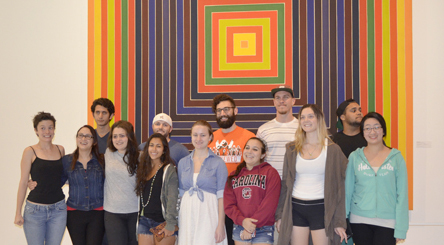Instructor Perspective
“I’m a dinosaur. I am the first to admit it, but I felt as if I entered some Jurassic Park populated by strange futuristic aliens in the ICT world of the early FLC meetings. All the faces were welcoming and voices encouraging, but I didn’t understand a thing they were saying. Kaltura, Diigo, Softchalk, PechaKucha, Thinglink, PowToons, Prezi, Mash Up’s all sounded like Yammer-ing to me. Then came Google, and around the table, tension slipped from faces, smiles lit up the circle, and excited chatter replaced sighs; we were all finally speaking a familiar language. For me that was the first step. Especially since the University was to launch its own Google platform the following fall, I could be on the cutting edge of integrating this accessible and universally embraced digital technology into my curricula.
Although Arts and Sciences still does not have the Google platform operational, my students and I are in the Cloud. My skill level with Google Docs is rudimentary, but all I need to do is open the gate and the students are off and Driving way ahead of me. One of the biggest benefits of using Google is the flexibility and ability to share and develop an idea or project that grows spontaneously out of consideration of texts and group discussion. The three courses in which Google has played a significant and surprising part are English Composition One and Two (ENG 105, Fall 2014, 19 students x 3 classes & ENG 106, Spring 2015, 19 students x 3 classes) and Intermediate Multi Genre Creative Writing (ENG 391, Spring 2015, 16 students.)
In my 105 Visual Rhetoric course, for example, the Dialogue with a Painting Assignment does not call for the collaborative Poems and Perceptions which are currently published on The Knight Center for International Media website. However after listening to actual face-to-face group discussion of the initial free writes posted on-line which familiarized everyone with immediate (informed by individual knowledge and values and unfiltered by the context of the peer group) responses to the One Water non-verbal documentary prompt film, the class launched into a collaborative project. Within minutes of an observation that the website featured an Education page, the class agreed on a collaborative project. One member of each group volunteered to collect all the Gmail accounts, set up the Google Doc, share with everyone, and engage all group members in the collective response to the film.
No begging for volunteers, no checking or monitoring, no additional work for me. Everybody participates, everybody has the opportunity and expectation for input, everybody questions and thinks critically, everybody has fun, everybody gets to be featured on the Knight Center Website, everybody wins. Since the students’ work is going out for their peers and parents to see, my notes become much more meaningful. Additional work for me is end-loaded, but I can structure my own deadline for publication on the website, and the benefits are bountiful. I get to work with the helpful folks at the Knight Center especially their webmaster, Gabriel, and I get to see that what I offer in my class has the potential to engage my students in a significant global conversation.
A similar lagniappe grew out of my Dialogue with a Painting assignment which I had dreamed would result in a dialectical relationship between word and image more accessible to a wider audience. So many road blocks made it seem impossible to share the project’s visual rhetoric, until my Creative Writing class made their conversations with art come alive on the Lowe Art Museum’s website. The students’ poems and stories prompted by the art which engaged them in conversation were posted in a Google Doc which was shared by the whole class and Education Curator Jodi Sypher and which could be edited and manipulated by all. The project could never have flown on the wings of enthusiasm alone, however. Without hands on trouble-shooting from Google Ambassador Valerie Quirk and the reassuring, confidence-inspiring, patient and persistent guidance by FLC and UMIT’s Cheyne Murray, the idea would have remained a dream.
Other projects integrating various digital technologies developed organically out of that FLC circle. Media Specialist, Vanessa Rodriguez came to an FLC meeting and has been helping my students make their voices heard ever since. One small class of writers (ENG 219) created, designed, and published their own books of poetry, stories and plays right in the Richter Media Lab. Others have chosen to present their research in Prezi’s and videos, using the technology and expert instruction available in the Media Lab.
Finally, with Google Docs I was able to synthesize the work of the semester for my ENG 106 rhetorical analysis course, Into the Wild, in a Google Doc, as a segeway to our final project. By the term’s end, technology delivered what I know to be the power of visual rhetoric to students weary of the printed word. From the internet I gathered information and critiques of theories presented by the verbal texts of the course, images illustrating their confluence of ideas, demonstrated citation format for internet sources as well as provided links to resources, and introduced the final project which called for synthesizing focused descriptions, identifying assumptions, reading through a lens, research and analysis. Not only did the Google Doc create a vehicle to bring together ideas, prompt questions, and point out assignment expectations, it also offered a model with which students could share their knowledge and understanding about the projects they designed and enthusiastically join the world-wide conversations made possible by digital technology.
Student Artifacts






